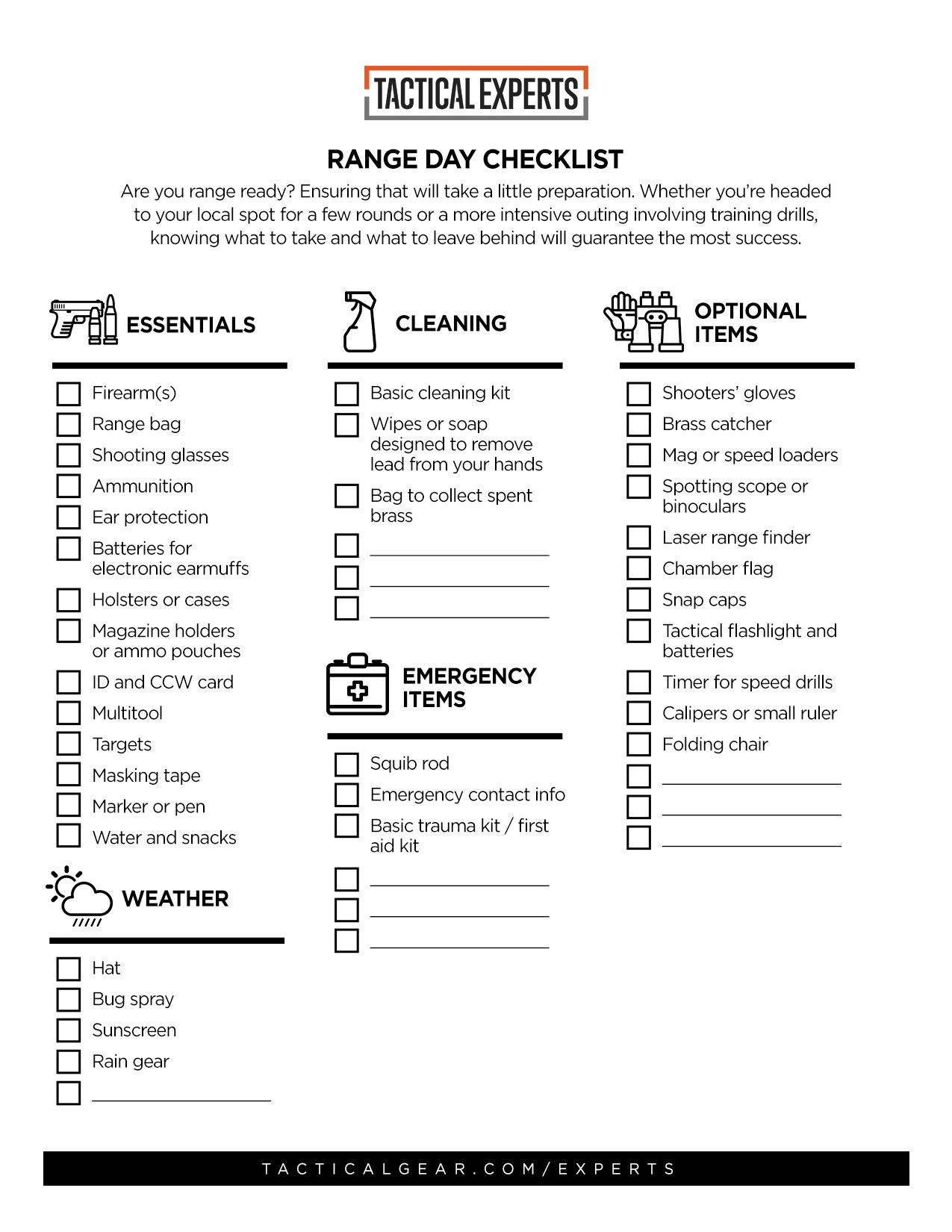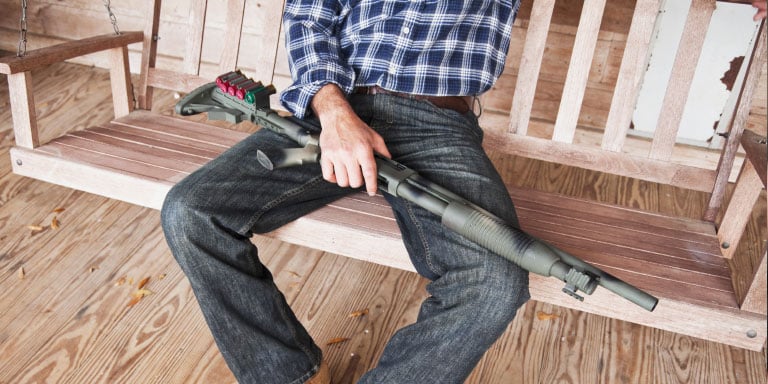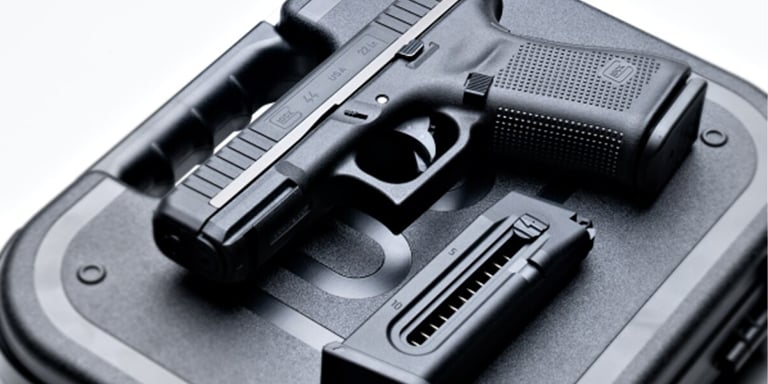
Share:
Range Day Checklist
Are you range ready? There's no better way to spend the day — provided it goes smoothly. Ensuring that will take a little preparation. Whether you're headed to your local spot for a few rounds or a more intensive outing involving training drills, knowing what to take and what to leave behind will guarantee the most success.
To determine what you'll need, consult our Range Day Checklist. It's designed to be deliberately comprehensive. Of course, it covers the essentials, but it also includes the small things you might not think about, such as extra batteries for electronic hearing protection, in case they run low while you're already out. Use our list as a guideline, or print the PDF version for easy use whenever.
Shooting Essentials
Let's start with the easy stuff: things you'll need in order to get any shooting done.
Firearm(s): Of course, you won't accomplish much at the range without at least one.
Range bag: Although most any medium or large bag will do for hauling your basic range supplies, a dedicated range bag has pockets and compartments designed specifically to hold and protect your weapons, ammunition, scopes, and other sensitive items.
Eye protection: Safety glasses are among the most important (and most often forgotten) pieces of essential range gear. Bring a dark-tinted pair if you'll be outside in bright sunlight.
Ear protection: If you're using foam ear plugs or non-electronic earmuffs, bring an extra pair in case the first one gets lost or broken.
Earmuff batteries: If you have electronic ear protection, ensure the batteries are fully charged before range day, and bring an extra set just in case.
Ammunition: Be sure to store your ammo in clearly marked containers that will protect it during transport. Hard-sided containers such as steel ammo cans are best. If you do store your ammo in your range bag, don't put anything else in the bag that could ruin or damage the ammo, such as liquids or heavy objects.
Holsters and cases: Most ranges require that your firearms be in a case or holster at all times when you aren't firing. Even if the range doesn't mandate that, it's still a good habit to maintain.
Magazine holders or ammo pouches: You'll want somewhere to keep extra ammo that's readily accessible, unless you plan to simply lay your mags or spare rounds on the shooting bench.
ID, CCW card, or hunting license: You'll always need to bring photo identification. Extra credentials are rarely mandatory, but some ranges won't let you practice certain kinds of shooting techniques (such as quick-draw drills with live ammunition) unless they see proof that you've completed a CCW course, hunter's safety course, or some other certification program. Call the range ahead of time to see if they have any such requirements.
Multi-tool: With a decent multi-tool, you can tweak your sights and perform basic repairs or adjustments to your firearms and to any other gear you bring along.
Targets: Of course, you'll need something to shoot at. If you plan to shoot pistols and rifles, plan on roughly one fresh paper target per 50–100 rounds, depending on the size of the target. Shotguns tear up paper targets much more quickly, so bring a dozen or more if it's scattergun day. Alternatively, you could bring more expensive but more durable self-healing targets, but check with the range ahead of time to see what they allow.
Masking tape: Tape is useful for mounting targets and for covering bullet holes to extend the life of paper targets. It's also handy as a temporary name label for your gear if other people at the range have similar-looking items.
Markers and pens: If you want to label your shot groups or otherwise track your performance throughout the day, you'll need something to write with.
Water and snacks: Bring enough water to last all day, and double the amount if you'll be at an outdoor range in extreme heat. Also bring snacks like beef jerky, nuts, or fruit—things that are easy to eat and dense with nutrients. Be sure to wash your hands thoroughly before eating at the range.
Cleaning Supplies
Cleaning up after cooking is less of a hassle when you wash dishes as you go. Similarly, a quick and basic cleaning session every few hours makes post-range cleanup a little more manageable.
Basic firearm cleaning kit: If you're anything like us, cleaning five or ten firearms at home after you've spent all day at the range is the least fun part of the day — but it's critical to clean your guns soon after firing them. Doing so while you're still at the range can spread the work out and make it more enjoyable.
"D-Lead" wipes or soap: When you're shooting for hours at a time, you're going to get lead, gunpowder and other stuff on your hands that can be dangerous if absorbed through your skin — especially if it happens regularly and over a long period of time. Periodically wash your skin with soap or wipes designed specifically to remove the grime that builds up from shooting.
Bag for brass: Some ranges expect you to at least make a concerted effort to collect the brass you fire and dispose of it yourself. Even if the range doesn't require you to clean up after yourself, it's still the polite thing to do. (But be sure to ask a range safety officer about their policies on cleaning up brass in front of the firing line.)
Emergency Items
Very few people bring a well-stocked emergency kit to the range. Such kits don't need to take up a ton of space, and by bringing one along, you'll have peace of mind knowing you're ready to help yourself or others if something goes seriously wrong.
Squib rod: A "squib" is a serious and dangerous malfunction in which a bullet becomes lodged in the barrel of a firearm. Squib rods are designed to force stuck bullets out of the barrel after the firearm has been safely disassembled.
Emergency contact info: Create a small card with your name, address, phone number, a summary of any medical conditions you may have, and contact information for your spouse or designated emergency contact. Laminate this card to protect it from the elements and keep it in your pocket where first responders can easily find it if an emergency arises.
Basic trauma kit: An individual first aid kit (IFAK) or basic medical kit is truly indispensable. Invest the time and money to create one and to familiarize yourself with the proper use of its contents.
Weather-Dependent Gear
Unless you're fortunate enough to live somewhere with gorgeous weather year-round, double check to ensure you have the right outdoor gear.
Hat: Prevent sunburn and protect your eyes from harsh glare with optimal headwear. If you live somewhere with snow or cold rain, invest in a warm hat that covers your ears, as well as scarfs, if needed.
Sunscreen: Apply sunblock every few hours if you're headed to an outdoor range, especially if your shooting station isn't covered by a roof or awning. Apply sunblock even if it isn't particularly hot — sunburn doesn't require high temperatures.
Bug spray: Nothing ruins a range day like itchy bug bites, so pack plenty of insect repellant.
Rain gear: If rain seems possible, bring a water-resistant jacket, poncho, ground covers, and/or towels — whatever you anticipate needing based on the layout of your local range. Be extra sure to have a plan to keep your weapons, scopes, and other fragile items clean and dry.
Optional Gear
You should have the essentials covered by now, but luxury items are certainly allowed. Here are some nice-to-have things that may make your next range day even more productive and enjoyable.
Shooters' gloves: If you've ever gone shooting for more than 2–3 hours at a stretch, you've probably gotten cuts or blisters on your hands at some point. A nice pair of shooting gloves can help prevent such annoyances, and they'll help keep your hands clean and dry, too.
Brass catcher: A bag hanging off your gun might look goofy, but it will save you a ton of time (and lower back pain) by negating the need to pick up your spent casings.
Magazine or speed loaders: Manually loading magazines or revolvers can get tedious pretty quickly. Speed up the process with these handy tools.
Spotting scope, binoculars, and rangefinder: If you're shooting beyond 25 meters or so, it's nice to be able to check your targets with binoculars so you don't have to wait for a ceasefire and then walk downrange. And if you plan on bringing a spotter to help with long-range marksmanship practice, they'll need a scope and/or rangefinder, along with extra batteries for the latter.
Chamber flag: A brightly-colored chamber flag makes it faster and easier for a range safety officer to confirm that your weapon is empty and clear during a ceasefire, and some ranges even require them.
Snap Caps: Bring dummy ammunition if you plan to practice techniques that don't require live rounds.
Tactical flashlight: If you're shooting at night or in a dark building (such as a shoothouse, also called a "hothouse" or "hellbox,") you'll definitely need a reliable, top-tier flashlight — and don't forget extra batteries.
Timer: If you'll be running any speed drills, bring a stopwatch or shot timer, along with any batteries it might require.
Calipers and ruler: If accuracy is your top priority, make sure you have tools to measure your shot groups.
Folding chair: Many outdoor ranges don't provide a place to sit, so be sure to bring your own! Cupholders and plush cushions are optional but highly recommended.
Did you find this article helpful?









